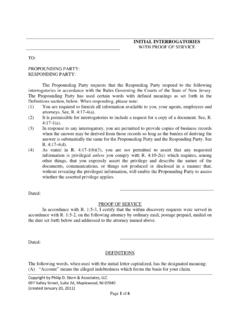Transcription of Storj A Peer-to-Peer Cloud Storage Network
1 Storj : A Decentralized Cloud Storage NetworkFrameworkStorj Labs, 30, 2018 Storj Labs, Inc. and SubsidiariesThis work is licensed under a Creative Commons Attribution-ShareAlike license (CC BY-SA ).All product names, logos, and brands used or cited in this document are property of their respective own-ers. All company, product, and service names used herein are for identification purposes only. Use of thesenames, logos, and brands does not imply .. 72 Storj design constraints.. and and S3 , device failure, and fault avoidance163 Framework.. communication and and implementation.. file node control and branding555 Walkthroughs.
2 Work.. files and content user experience around metadata647 Selected calculations.. repair false positive erasure parameters69 ADistributed consensus.. 73 BAttacks.. 76 CPrimary user benefits.. AbstractDecentralized Cloud Storage represents a fundamental shift in the e ciency and eco-nomics of large-scale Storage . Eliminating central control allows users to store and sharedata without reliance on a third-party Storage provider. Decentralization mitigates therisk of data failures and outages while simultaneously increasing the security and privacyof object Storage . It also allows market forces to optimize for less expensive Storage at agreater rate than any single provider could a ord.
3 Although there are many ways to buildsuch a system, there are some specific responsibilities any given implementation shouldaddress. Based on our experience with petabyte-scale Storage systems, we introduce amodular framework for considering these responsibilities and for building our distributedstorage Network . Additionally, we describe an initial concrete implementation for theentire ContributorsThis paper represents the combined e orts of many individuals. Contributors a liatedwith Storj Labs, Inc. include but are not limited to: Tim Adams, Kishore Aligeti, CameronAyer, Atikh Bana, Alexander Bender, Stefan Benten, Maximillian von Briesen, Paul Cannon,Gina Cooley, Dennis Coyle, Egon Elbre, Nadine Farah, Patrick Gerbes, John Gleeson, BenGolub, James Hagans, Jens Heimb rge, Faris Huskovic, Philip Hutchins, Brandon Iglesias,Viktor Ihnatiuk, Jennifer Johnson, Kevin Le ew, Alexander Leitner, Richard Littauer, DylanLott, JT Olio, Kaloyan Raev, Garrett Ransom, Matthew Robinson, Jon Sanderson, BenjaminSirb, Dan Sorensen, Helene Unland, Natalie Villasana, Bryan White.
4 And Shawn d also like to thank the other authors and contributors of the previous Storj andMetadisk white papers: Tome Boshevski, Josh Brando , Vitalik Buterin, Braydon Fuller,Gordy Hall, Jim Lowry, Chris Pollard, and James d like to especially thank Petar Maymounkov, Anand Babu Periasamy, Tim Kosse,Roberto Galoppini, Steven Willoughby, and Aaron Boodman for their helpful review ofand contributions to an early draft of this would like to acknowledge the e orts, white papers, and communications of othersin the distributed computing, blockchain, distributed Storage , and decentralized storagespace, whose work has informed our e orts.
5 A more comprehensive list of sources is in thebibliography, but we would like to provide particular acknowledgement for the guidanceand inspiration provided by the teams that designed and built Allmydata, Ceph, Coral-CDN, Ethereum, Farsite, Filecoin, Freenet, Gluster, GFS, Hadoop, IPFS, Kademlia, Lustre,Maidsafe, Minio, MojoNation, OceanStore, Scality, Siacoin, and , we extend a huge thank you to everyone we talked to during the design andarchitecture of this system for their valuable thoughts, feedback, input, and address correspondence to IntroductionThe Internet is a massive decentralized and distributed Network consisting of billions ofdevices which are not controlled by a single group or entity.
6 Much of the data currentlyavailable through the Internet is quite centralized and is stored with a handful of tech-nology companies that have the experience and capital to build massive data centerscapable of handling this vast amount of information. A few of the challenges faced bydata centers are: data breaches, periods of unavailability on a grand scale, Storage costs,and expanding and upgrading quickly enough to meet user demand for faster data andlarger Storage has emerged as an answer to the challenge of providing a per-formant, secure, private, and economical Cloud Storage solution. Decentralized Storage isbetter positioned to achieve these outcomes as the architecture has a more natural align-ment to the decentralized architecture of the Internet as a whole, as opposed to massivecentralized data coverage of data breaches over the past few years has shown us that the fre-quency of such breaches has been increasing by as much as a factor of 10 between 2005and 2017 [1].
7 Decentralized Storage s process of protecting data makes data breachesmore di cult than current methods used by data centers while, at the same time, cost-ing less than current Storage model can address the rapidly expanding amount of data for which current solu-tions struggle. With an anticipated 44 zettabytes of data expected to exist by 2020 anda market that will grow to $92 billion USD in the same time frame [2], we have identifiedseveral key market segments that decentralized Cloud Storage has the potential to ad-dress. As decentralized Cloud Storage capabilities evolve, it will be able to address a muchwider range of use cases from basic object Storage to content delivery networks (CDN).
8 Decentralized Cloud Storage is rapidly advancing in maturity, but its evolution is subjectto a specific set of design constraints which define the overall requirements and imple-mentation of the Network . When designing a distributed Storage system, there are manyparameters to be optimized such as speed, capacity, trustlessness, Byzantine fault toler-ance, cost, bandwidth, and propose a framework that scales horizontally to exabytes of data Storage acrossthe globe. Our system, the Storj Network , is a robust object store that encrypts, shards,and distributes data to nodes around the world for Storage . Data is stored and served in amanner purposefully designed to prevent breaches.
9 In order to accomplish this task, we vedesigned our system to be modular, consisting of independent components with task-specific jobs. We ve integrated these components to implement a decentralized objectstorage system that is not only secure, performant, and reliable but also significantly moreeconomical than either on-premise or traditional, centralized Cloud 1. Introduction8We have organized the rest of this paper into six additional chapters. Chapter 2 dis-cusses the design space in which Storj operates and the specific constraints on which ouroptimization e orts are based. Chapter 3 covers our framework. Chapter 4 proposes asimple concrete implementation of the framework, while chapter 5 explains what hap-pens during each operation in the Network .
10 Chapter 6 covers future work. Finally, chapter7 covers selected Storj design constraintsBefore designing a system, it s important to first define its requirements. There are manydi erent ways to design a decentralized Storage system. However, with the addition of afew requirements, the potential design space shrinks significantly. Our design constraintsare heavily influenced by our product and market fit goals. By carefully considering eachrequirement, we ensure the framework we choose is as universal as possible, given Security and privacyAny object Storage platform must ensure both the privacy and security of data storedregardless of whether it is centralized or decentralized.






